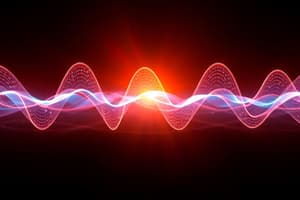Podcast
Questions and Answers
A wave is traveling through a medium. If the frequency of the wave increases while the wave speed remains constant, what happens to the wavelength?
A wave is traveling through a medium. If the frequency of the wave increases while the wave speed remains constant, what happens to the wavelength?
- Wavelength increases.
- Wavelength decreases. (correct)
- Wavelength fluctuates randomly.
- Wavelength remains constant.
Which characteristic is unique to electromagnetic waves compared to mechanical waves?
Which characteristic is unique to electromagnetic waves compared to mechanical waves?
- They require a medium to propagate.
- They can transmit energy.
- They can travel through a vacuum. (correct)
- They exhibit diffraction.
Consider two waves approaching each other in the same medium. Which phenomenon best describes what happens when these waves meet?
Consider two waves approaching each other in the same medium. Which phenomenon best describes what happens when these waves meet?
- Diffraction
- Reflection
- Refraction
- Superposition (correct)
In a transverse wave, what is the relationship between the direction of particle oscillation and the direction of wave propagation?
In a transverse wave, what is the relationship between the direction of particle oscillation and the direction of wave propagation?
A sound wave passes from air into water. Which property of the wave will remain the same?
A sound wave passes from air into water. Which property of the wave will remain the same?
When light passes through a prism, it separates into different colors. Which wave phenomenon is primarily responsible for this separation?
When light passes through a prism, it separates into different colors. Which wave phenomenon is primarily responsible for this separation?
Which of the following is an example of a longitudinal wave?
Which of the following is an example of a longitudinal wave?
If a wave encounters a barrier with a small opening, what phenomenon allows the wave to spread out after passing through the opening?
If a wave encounters a barrier with a small opening, what phenomenon allows the wave to spread out after passing through the opening?
What happens to the wavelength of an electromagnetic wave as its frequency increases?
What happens to the wavelength of an electromagnetic wave as its frequency increases?
A penny dropped in a fountain creates ripples. What action would increase the amplitude of these waves?
A penny dropped in a fountain creates ripples. What action would increase the amplitude of these waves?
Which type of electromagnetic wave is commonly used to create images of internal organs due to its ability to easily travel through solids?
Which type of electromagnetic wave is commonly used to create images of internal organs due to its ability to easily travel through solids?
What property of a wave is defined as the distance between a point on one wave to the equivalent point on the next wave?
What property of a wave is defined as the distance between a point on one wave to the equivalent point on the next wave?
Which of the following describes a longitudinal wave?
Which of the following describes a longitudinal wave?
Which type of electromagnetic wave is associated with the colors of the rainbow (ROYGBIV)?
Which type of electromagnetic wave is associated with the colors of the rainbow (ROYGBIV)?
Which application most commonly utilizes infrared waves?
Which application most commonly utilizes infrared waves?
What can be determined if 5 waves pass a point in 15 seconds?
What can be determined if 5 waves pass a point in 15 seconds?
A wave generator produces waves at a frequency of 5 Hz. If the wavelength of these waves is 1.2 meters, what is the speed of the waves?
A wave generator produces waves at a frequency of 5 Hz. If the wavelength of these waves is 1.2 meters, what is the speed of the waves?
Waves pass by two docks that are 20.0 m apart. If the wavelength of a single wave is 5.0 m, and their frequency is 0.25 Hz, what is the wave speed?
Waves pass by two docks that are 20.0 m apart. If the wavelength of a single wave is 5.0 m, and their frequency is 0.25 Hz, what is the wave speed?
During a lab, a student creates waves with a Slinky. The wavelength of the waves is 0.75 meters, and the wave speed is 3 m/s. What is the frequency of the waves?
During a lab, a student creates waves with a Slinky. The wavelength of the waves is 0.75 meters, and the wave speed is 3 m/s. What is the frequency of the waves?
The speed of a sound wave is 340 m/s and the frequency is 256 Hz. What is the wavelength of the sound wave?
The speed of a sound wave is 340 m/s and the frequency is 256 Hz. What is the wavelength of the sound wave?
If the wave speed is 345 m/s and the wavelength is 1.5 meters, what formula calculates the frequency?
If the wave speed is 345 m/s and the wavelength is 1.5 meters, what formula calculates the frequency?
A radar gun uses which wave behavior to determine the speed of a moving vehicle?
A radar gun uses which wave behavior to determine the speed of a moving vehicle?
Why do classroom ceilings use soft, porous tiles?
Why do classroom ceilings use soft, porous tiles?
Corrective eyeglasses utilize which wave behavior to improve vision?
Corrective eyeglasses utilize which wave behavior to improve vision?
Flashcards
Frequency vs. Wavelength
Frequency vs. Wavelength
As wave frequency increases, the wavelength decreases.
Longitudinal Wave
Longitudinal Wave
Waves in which the motion of the medium is parallel to the direction of the wave.
Wavelength
Wavelength
The distance between one point of a wave to the same point in the next wave.
Frequency
Frequency
Signup and view all the flashcards
X-Rays
X-Rays
Signup and view all the flashcards
Visible Light
Visible Light
Signup and view all the flashcards
Infrared Waves
Infrared Waves
Signup and view all the flashcards
Transverse Waves
Transverse Waves
Signup and view all the flashcards
Wave
Wave
Signup and view all the flashcards
Mechanical Wave
Mechanical Wave
Signup and view all the flashcards
Electromagnetic Wave
Electromagnetic Wave
Signup and view all the flashcards
Electromagnetic Spectrum
Electromagnetic Spectrum
Signup and view all the flashcards
Wave Speed
Wave Speed
Signup and view all the flashcards
Reflection
Reflection
Signup and view all the flashcards
Scattering
Scattering
Signup and view all the flashcards
Refraction
Refraction
Signup and view all the flashcards
Transmission
Transmission
Signup and view all the flashcards
Absorption
Absorption
Signup and view all the flashcards
Study Notes
- Waves transfer energy through a medium.
- Mechanical waves require matter to travel through.
- Mechanical waves can move as transverse or longitudinal waves.
- Transverse mechanical waves travel perpendicular to the energy transfer direction (example: light).
- Longitudinal mechanical waves travel parallel to the energy transfer direction (example: sound).
- Waves that can travel through matter or a vacuum are electromagnetic (example: light).
- Electromagnetic waves travel in the form of waves and are made of vibrating electric and magnetic fields.
- Not all electromagnetic waves travel at the same speed as they depend on the medium.
- With an increase in the electromagnetic wave frequency observed length decreases.
- X-rays can easily travel through solids and generate images of internal organs.
- Wavelength is the distance between identical points on consecutive waves.
- Frequency is the number of waves per unit of time.
- Longitudinal waves occur when the medium's motion is parallel to the wave's direction.
- Visible light waves has a color spectrum known as ROYGBIV (Red, Orange, Yellow, Green, Blue, Indigo, Violet).
- Infrared waves cause molecule vibrations.
- Radio waves are generated by devices like cell phones.
- Transverse waves occur when the medium's motion is perpendicular to the wave's direction.
- Infrared waves are used in heat lamps.
- Ultraviolet waves cannot be seen by humans however the properties of the waves are utilised by insects to locate plants.
- X-rays are electromagnetic waves with the shortest wavelength and highest frequency.
Important Vocabulary
- Absorption
- Amplitude
- Compression
- Compressional/Longitudinal Wave
- Crest
- Diffraction
- Disturbance
- Electromagnetic Wave
- Electromagnetic Spectrum
- Frequency
- Mechanical Wave
- Medium
- Midline
- Rarefaction
- Reflection
- Refraction
- Scattering
- Superposition
- Transmission
- Transverse Wave
- Wave
- Wavelength
Studying That Suits You
Use AI to generate personalized quizzes and flashcards to suit your learning preferences.
Related Documents
Description
Explore wave energy transfer, mechanical vs. electromagnetic waves, and transverse and longitudinal wave characteristics. Examine frequency, wavelength, and the behavior of electromagnetic waves in different mediums. Learn about X-rays and their applications in medical imaging.




